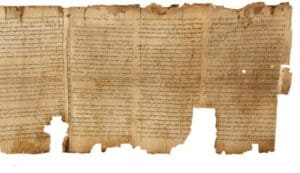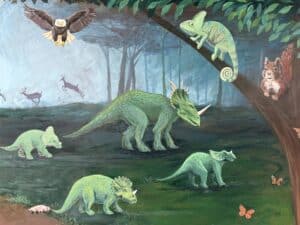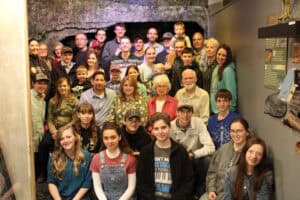
Using the Means God has Provided
“Evidence. People say they will believe something if there is enough evidence. But on certain subjects many have a priori already made up their minds and are unwilling to change.”

As a former tour guide at the Creation Experience Museum, one of my favorite artifacts to show was our Dead Sea Scroll exhibit. These 2,000 year old scrolls, riddled with adventure and mystery, provide one of the greatest archeological discoveries of all time and an astonishing testament to the reliability of God’s word. But it’s not just the scrolls themselves that are amazing. The story of their discovery is filled with intrigue, drama, and novel rivaling material.
As Professor John Trevor labored over his studies on plants and animals of the Bible at the American School of Oriental Research in Jerusalem, a phone call interrupted his studies. The date was February 18th, 1948 and it was on this early spring day that Trevor would become the first American to hear of the Dead Sea Scrolls.
On the other end of the telephone was Butrus Sowmy, the librarian of the Syrian Orthodox Church in Jerusalem. He had a question: Would someone at Professor Trevor’s school be able to provide information on two scrolls that had been purchased by the monastery? After some thought, Trevor agreed to try it and set the time for Sowmy to bring the scrolls the following afternoon.
Less than a year prior to this important, stage-setting phone call an entirely different drama was in the works in twentieth century Palestine. Three Bedouin shepherds were tending their flocks in the Qumran area of the Dead Sea. One of them saw a cave opening high above them and threw a stone into it. To his amazement he heard the breaking of pottery. Thinking it might be a long-buried treasure, he mentioned it to his fellow shepherds who agreed to explore it the following day.
In the morning, the youngest among them, impatient to satisfy his curiosity, left before the other two awoke and hastened back to the mysterious cave. After some effort, he slid into the cave’s mouth and found several ancient jars. Many were broken, several were empty, two were full. And between the two, one was filled with clay. The other contained three scrolls. The young shepherd gathered up these scrolls, slipped out of the crevice that may not have been touched by human hands and feet for two thousand years, and returned to his fellows.
 For the next several months, the scrolls were handled by a flurry of hands before landing among the monks of St. Mark. The first hands and eyes to experience them were those of the Bedouins’ relatives before being returned to their distinguished place hanging from the tent post. They then passed among various dealers and peddlers as the Bedouins tried to sell them with the eventual sale being less than $30 in then-current American dollars. None imagined what a spectacular discovery had been made.
For the next several months, the scrolls were handled by a flurry of hands before landing among the monks of St. Mark. The first hands and eyes to experience them were those of the Bedouins’ relatives before being returned to their distinguished place hanging from the tent post. They then passed among various dealers and peddlers as the Bedouins tried to sell them with the eventual sale being less than $30 in then-current American dollars. None imagined what a spectacular discovery had been made.
All of this was also true of Professor Trevor as 2:30pm rolled around on that February afternoon. Trevor describes his initial sighting of the first scroll this way,
“Laying the heavy document on my bed, slowly I began to open it. A sheet of leather, containing two columns of text, had become detached from the rest of the document. The linen thread used to bind the sheets together has disintegrated. On the left edge the text was badly blurred by someone who had attempted to re-ink many letters which had been worm away by handling…Here was not what I had expected! The script was puzzling…I had expected the identification to be easy, but this scroll was different. It fired my imagination.”
By cautious study and patient endurance, Trevor and a fellow researcher would eventually unfold the content of this scroll and three others belonging to the church library. Research on the scrolls and the first attempt to the Qumran caves would be complicated by another monumental event taking place the same year: the establishment of the state of Israel. As a result, the Syrian Orthodox Church would move the scrolls to the Untied States for safe-keeping.
 In the years to come, over 15,000 fragments representing 800-900 different documents would be found in 11 caves, dating from 3rd century BC to just prior to the destruction of Jerusalem in 70 AD. Among these, a remarkable number were from Old Testament books. These manuscripts in particular pushed our earliest copies of Scripture back hundreds of years and gave us some of the greatest archeological evidence of God’s promise to preserve His written word.
In the years to come, over 15,000 fragments representing 800-900 different documents would be found in 11 caves, dating from 3rd century BC to just prior to the destruction of Jerusalem in 70 AD. Among these, a remarkable number were from Old Testament books. These manuscripts in particular pushed our earliest copies of Scripture back hundreds of years and gave us some of the greatest archeological evidence of God’s promise to preserve His written word.
As for that first scroll Professor Trevor unrolled, it would prove to be the famous Great Isaiah Scroll, the only scroll to be almost entirely complete and with a copied date about 100 years before the birth of the Messiah its prophet foretold. But perhaps the most awe-inspiring of all is the message of the verse that revealed the scroll’s identity to Trevor:
“I was sought by those who did not ask for Me; I was found by those who did not seek Me. I said, ‘Here I am, here I am,’ To a nation that was not called by My name.”
Isaiah 65:1
Based on The Dead Sea Scrolls: A Personal Account. John C. Trevor
Other consulted sources:
www.britannica.com/topic/Dead-Sea-Scrolls, accessed 8/9/24
www.deadseascrolls.org.il, accessed 8/9/24

“Evidence. People say they will believe something if there is enough evidence. But on certain subjects many have a priori already made up their minds and are unwilling to change.”

Christmas in Branson, Missouri Light Displays, Family Attractions, and a Free Dinosaur Experience If you’re dreaming of a classic Ozark Mountain Christmas, put Branson, Missouri

Evolutionists use birds as major evidence for their theory. What does aviary evidence actually point us to though?

Meet our crew! In this article we give a brief insight to all of the amazing people that make Creation Ministries of the Ozarks work.
